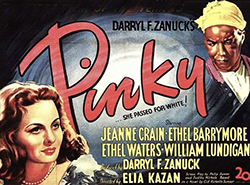‘You Can’t Show That!’
.jpg) |
|
Historian Laura Wittern-Keller, before a poster of the cover of her 2008 work, Freedom of the Screen. (Photo by Mark Schmidt) |
ALBANY, N.Y. (November 17, 2017) — Some Americans are aware that the path to ending state censorship of the movies was a long but successful one, resulting in an enormous expansion of what we can see and hear in the theater.
Most do not realize, however, that this road to cinematic freedom contributed directly to expanded First Amendment protections of artistic expression.
Laura Wittern-Keller, a full-time lecturer in History since 2007, brought this fact to light in her book Freedom of the Screen: Legal Challenges to State Film Censorship, 1915-1981 (2008). Now, through the Foundation for Individual Rights in Education (FIRE), she has created a timeline, The History of Film Censorship, encapsulates that history through 68 milestones illustrated with colorful photos, brief synopses and links to additional written materials and film clips.
Wittern-Keller, who received her history bachelor’s at UAlbany and her master’s at Penn State before returning to UAlbany for her Ph.D. (2003), said the heroes in the battle of the motion picture were not the major studios, though they profited from the victory.
“It wasn’t the studios, but independent producers and distributors who had no other option but to fight against it the only way they could — in the courts,” said Wittern-Keller. “They only started to win after WWII, when the shield of censor invincibility that had existed until then began to fall away.
“In winning, these brave and today largely unrecognized independent producers and distributors expanded the meaning of the First Amendment.”
The timeline chronicles how film distributor Jake Block of Chicago protested the city’s banning of films, because of what it deemed immoral or obscene content, all the way back in 1909. Block lost his case in the Illinois Supreme Court, as did many after him. The timeline follows the anti-censorship battles that occurred case by case through state courts and the U.S. Supreme Court, with judges and the public gradually growing sympathetic toward artistic freedom.
 |
|
Wittern-Keller's film censorship timeline includes the 1952 Supreme Court ruling overturning the banning of the move Pinky, which dealt with miscegenation, in Marshall, Texas. |
Wittern-Keller used previously unexplored archival material, much of it found during her Ph.D. dissertation work at the New York State Archives. She recalls a visit there where she practically “fell into a pile of research” on the topic of film censorship. “An archivist said, ‘We have all the film censorship papers here, but no one ever uses them for public policy research.’”
Eagerly attacking those archives, Wittern-Keller expected to find disputes and court cases involving the major studios. “But the biggest, fattest files involved the distributors whose movies were banned. They were the ones who fought through the courts for artistic freedom.”
She estimates, at its height, about 41 percent of the U.S. was covered by government film censorship. Six states, including New York, adopted film censorship statutes and censorship commissions by 1922. Hollywood itself, the timeline shows, imposed its own restrictions upon content from 1934 into World War II.
“WWII changes everything,” said Wittern-Keller. “Did men coming home from the Battle of the Bulge really want to see Rebecca of Sunnybrook Farm? The demand became strong for more realism, including the dark themes of film noir.”
Wittern-Keller’s timeline plots the progress of film freedom — much of it in the U.S. Supreme Court — from the distribution of more realistic foreign films like The Miracle (1948) to overturning the anti-miscegenation rulings of southern states over the film Pinky (1952), to the end of state censorship laws, to the introduction of films more explicit sexually and in language usage.
“Film, she said, “went from the most controlled medium to the most un-controlled medium,” she said, adding that she has sympathy for the many of censors whose major goal was to protect children from violent and other explicit content.
She now is at work on a book that will take a broader look at movie censorship. “I’m researching all the ways that have affected movie content: government censorship, pressure groups such as the Catholic Legion of Decency, the FBI, the CIA, the Pentagon — did you know the Pentagon has to see a script before your production crew can use an aircraft carrier? — even the airlines’ control of movies shown on long-distance flights.
“It will cover anything that affects film content. It’s a big project.”
![]() For more news, subscribe to UAlbany's RSS headline feeds
For more news, subscribe to UAlbany's RSS headline feeds
A comprehensive public research university, the University at Albany-SUNY offers more than 120 undergraduate majors and minors and 125 master's, doctoral and graduate certificate programs. UAlbany is a leader among all New York State colleges and universities in such diverse fields as atmospheric and environmental sciences, business, education, public health,health sciences, criminal justice, emergency preparedness, engineering and applied sciences, informatics, public administration, social welfare and sociology, taught by an extensive roster of faculty experts. It also offers expanded academic and research opportunities for students through an affiliation with Albany Law School. With a curriculum enhanced by 600 study-abroad opportunities, UAlbany launches great careers.


